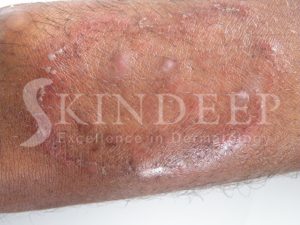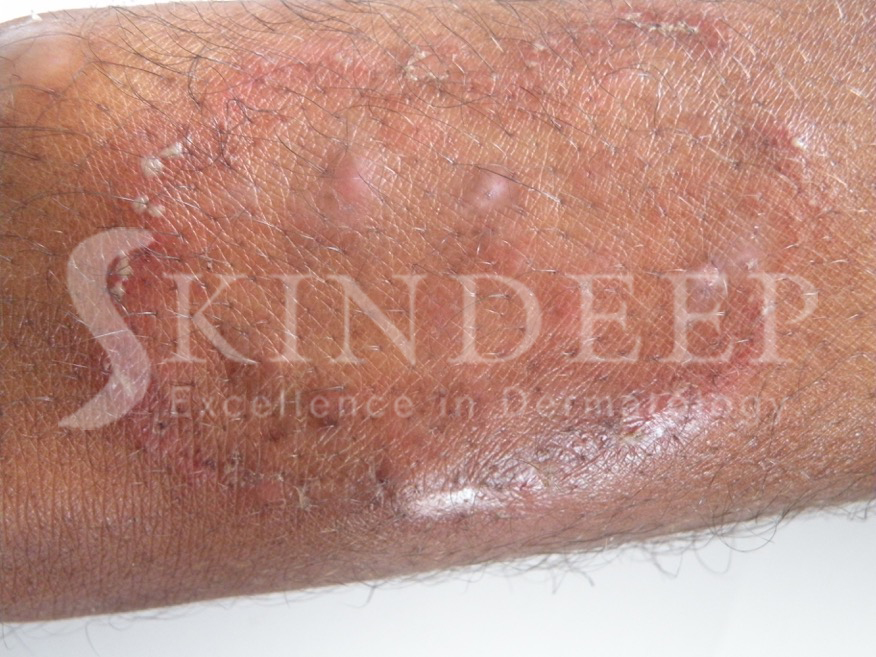Tinea refers to a type of infection caused by fungi. Dermatophyte fungi of the genera Trichophyton, Microsporum and Epidermophyton cause these infections. These fungi invade the upper layer of the skin composed of keratin and also affect the hair and nails.

Infections can spread from person to person (anthropophilic), animals to man (zoophilic) and less commonly from the soil to man (geophilic). The names of the various types of infections may seem complicated but are based on the part of the body, which is affected.
CLINICAL PRESENTATIONS
Tinea corporis occurs on the trunk and limbs and consist of oval plaques with raised scaling edges and central healing. The edges of these ring like lesions may also contain papules or pustules. In the acute phase pustules and vesicles are common while scaling occurs in older lesions. These patches may be single or multiple but tend to be asymmetrically distributed.
Tinea capitis is a chronic scalp infection usually affecting children under 12 yrs of age. It starts as scattered areas of scalp dryness and can progress to generalised dandruff. Single or multiple oval patches of hair loss may contain black dots (broken hairs), dryness, pustules or a swollen abscess like mass (kerion). Yellow crusting and exudates (wetness) can also be associated with severe infection. Swollen glands (lymph nodes) appear in the neck.
Tinea pedis (athlete’s foot) affects the feet and is usually asymmetrical. This is the most common of the infections and occurs predominantly in men. There are three main patterns:
- Moist peeling and cracking of the skin between the toes
- A moccasin – type pattern consisting of powdery dryness, peeling and scaling of one sole
- Acute infections present as small fluid filled structures called vesicles before forming blisters. These can affect the soles and between the toes.
Fungal spores persist for months in bathrooms, changing rooms and swimming pools. Walking bare footed and sharing towels can cause infection.
Tinea ungium can affect one or more nails and presents in various ways. Crumbling of the end of the nail associated with unsticking and scaling under the nail. The surface or lateral border can have a white or yellow flaking as well and in severe cases the entire nail can be destroyed.
Tinea facei is the name given to infections involving the face. The appearance can be classical but zoophilic infections are often misdiagnosed due to the pustular appearance. When the beard area is involved the infection is called Tinea Barbae.
Tinea manum is less common and presents as powdery scaling of the creases of one palm. A cause of jock itch is Tinea cruris, which affects the groin unilaterally or bilaterally.
Even though Tinea is a common infection, individuals and doctors can sometimes use steroid containing creams creating a condition called Tinea incognito. This results in spreading of the infection and a loss of the characteristic skin changes. Patients with this form of tinea experience cyclical apparent improvement when on the steroid treatment and apparent spreading and exacerbation with cessation. This observation reinforces the inappropriate use of the steroid cream.
TREATMENT
Simple Tinea infections affecting the skin can be treated with antifungal lotions, creams and shampoos. Infections of the scalp, nails and chronic widespread skin infections require oral antifungal treatments. Fingernails require 6-8 weeks while toenails require three months.
Scalp ringworm requires two months of oral medication but children can attend school during treatment, providing the lesions are not weeping or pustular. Simple hygienic practices as well as avoiding the sharing of combs, hats, pillowcases and frequent use of an antifungal shampoo help to prevent spread.

